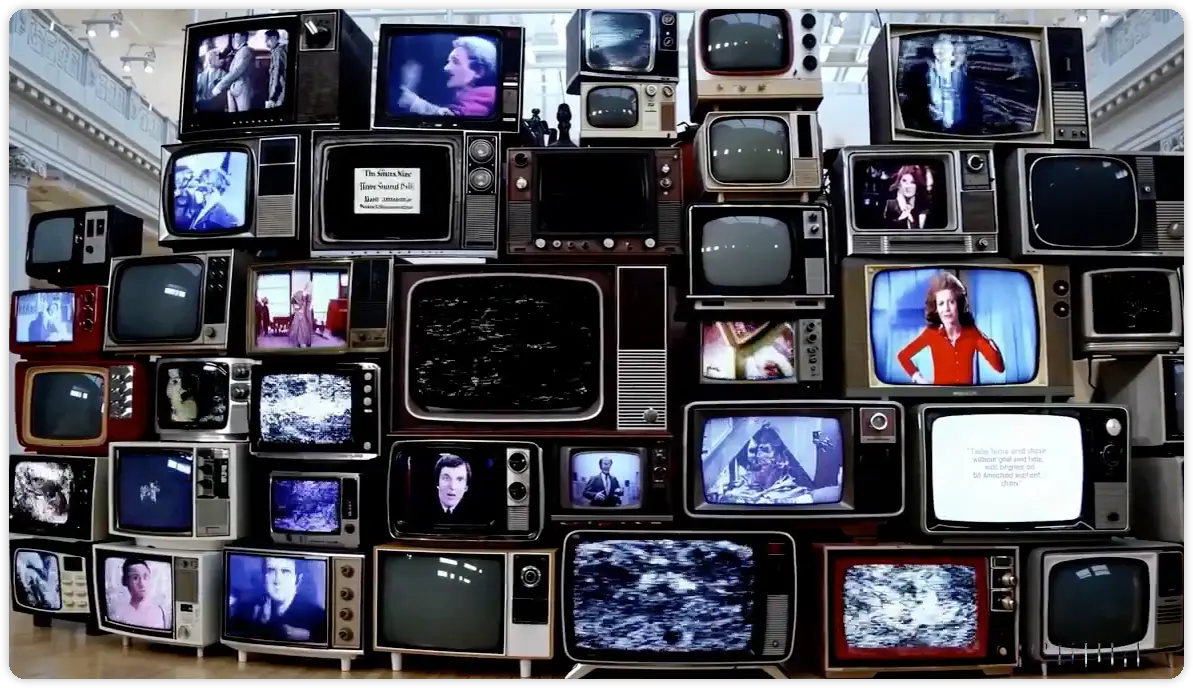
- Published on
- Updated on
SORA AI Video: Step back in time and relive classic TV memories!
- Authors

- Name
- Sora Ai Video

- Name
- OpenAI
- @OpenAI

- Name
- Julie W. Design
- @juliewdesign_
Introduction
Step into a visual symphony of nostalgia and innovation with the latest Sora AI video exhibit at a New York museum gallery.
OpenAI's Sora seamlessly blends the past and the future, creating a text-to-video masterpiece where vintage televisions form a grand installation, each screen a portal to a different era. From the eerie silence of 1950s sci-fi movies to the hearty laughs of a 1970s sitcom, this exhibit captures the evolution of entertainment.
The static buzz, the anchor's solemn report, and the thrill of horror flicks all come alive, demonstrating Sora's cutting-edge ability to resurrect history through its advanced AI video generation.
- video preview
- video prompt
- text to video prompt analysis structure
- how to build similar high-quality tips (text to video prompt) ?
- Generate widespread discussion on Twitter
- How to get access to Sora?
video preview

In this video, we see a bunch of old-fashioned TVs placed in an art gallery, each showing a different program.
From 1950s science fiction films, horror films, and news broadcasts to 1970s sitcoms, a wide variety of images are woven together to showcase the rich diversity of television history.
This is not just a collection of exhibits, they are like windows in time, each TV is a door to the past.
video prompt
Prompt: The camera rotates around a large stack of vintage televisions all showing different programs — 1950s sci-fi movies, horror movies, news, static, a 1970s sitcom, etc, set inside a large New York museum gallery.
text to video prompt analysis structure
To analyze the structure and logic of the prompt provided, we will employ the Structured Thinking model, which involves breaking down the information into key components and understanding their interrelationships. Here's how this model can be applied to the prompt about the image of the vintage televisions:
1. Identification of Components:
- Subject: A large stack of vintage televisions.
- Action: The camera is rotating around this stack.
- Content: The televisions are displaying different programs, including 1950s sci-fi and horror movies, news, static, and a 1970s sitcom.
- Setting: Inside a large New York museum gallery.
2. Relationships and Hierarchies:
- The subject (vintage televisions) is central and serves as the focal point for the action (camera rotation).
- The content displayed on each television represents a different facet of the overall theme, which is the historical evolution of broadcast content.
- The setting provides context and elevates the subject, indicating this is an exhibit meant for public viewing and appreciation.
3. Purpose and Intent:
- The intention behind the camera rotation is to give a comprehensive view of the entire collection, showcasing the diversity of the content.
- The display of different programs across different eras serves to highlight the technological progress and the changing nature of entertainment and information dissemination over the years.
- Placing the exhibit in a New York museum gallery suggests a purpose of education and cultural reflection, giving viewers insight into the history of television and its impact on society.
4. Logical Flow:
- The prompt starts by establishing the subject and action, which sets the stage for the viewer.
- It then details the content, creating a connection between the viewer and the various time periods represented.
- Finally, the setting grounds the experience in a recognizable and prestigious location, adding to the significance of the exhibit.
5. Conclusion: The prompt describes a dynamic and visually engaging exhibit that uses the motion of the camera to draw the viewer into a historical journey through the evolution of television programming. The display not only showcases technological artifacts but also serves as a timeline of cultural change, encapsulated within the esteemed environment of a New York museum.
This structured analysis allows us to understand the prompt's components and their connections, revealing the purpose behind the exhibit and the intended experience for the audience.
how to build similar high-quality tips (text to video prompt) ?
To construct a high-quality prompt similar to the one provided, which is detailed and evokes a vivid image or scenario, one can follow these steps:
1. Establish the Scene or Subject:
- Choose a focal point for your prompt that will capture the viewer's interest. This could be an object, an event, or a setting.
2. Add Context and Detail:
- Provide specifics that add depth to the scene. This could include historical context, visual details, colors, textures, or actions occurring within the scene.
3. Evoke the Senses:
- Use descriptive language that appeals to the senses. Describe what one might see, hear, or feel when witnessing the scene you are creating.
4. Incorporate Movement or Change:
- Introduce an element of motion or progression to give the scene dynamism. This could be the movement of the camera, the evolution of an event, or a transition from one state to another.
5. Set the Tone and Mood:
- Decide on the emotional response you want to elicit from the viewer. The choice of words can create a mood that is nostalgic, exciting, eerie, joyful, etc.
6. Provide a Purpose or Intent:
- Make it clear why the scene is worth noting. Is it educational, entertaining, reflective, or something else?
7. Use Varied and Rich Vocabulary:
- Choose words that are precise and varied to avoid repetition and to keep the reader engaged.
8. Keep It Structured:
- Ensure there is a logical flow from the introduction of the scene to the details and the conclusion of the prompt.
9. Edit for Clarity and Brevity:
- Review your prompt to ensure that it is clear, concise, and free of unnecessary information.
10. Test Your Prompt:
- Imagine the scene yourself or share it with others to see if it conjures the intended image or emotion.
By following these steps, even those who are not professional writers can create prompts that are rich in detail and evoke a strong visual and emotional response.
Generate widespread discussion on Twitter
time: 2:38 AM · Feb 16, 2024
counts: 613.2K Views
How to get access to Sora?
Waiting for openai to be opened one after another.
Or follow us and give you the fastest notification !